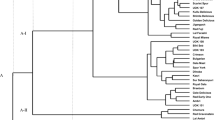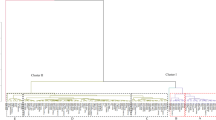Abstract
Thirty-six apple cultivars representing Malus × domestica Borkh. were evaluated for diversity in fruit quality. Colour traits ‘L’, ‘b’ and ‘Tint’ were positively correlated with TSS and fruit size. ‘a’ values showed negative correlation with TSS but was positively correlated with fruit firmness. ‘L’ values ranged from 32.66 (Well Spur) to 76.48 (Supermore Gold). Negative ‘a’ value was observed for Orange Val (−5.17), Snow Drift (−1.67) and Greensleeves (−7.70) indicating that these cultivars are green in colour at the time of harvesting. The ‘b’ values ranged from 6.86 (King Hacious) to 52.18 (Supermore Gold) indicating that these cultivars are yellow in colour and none blue. Positive ‘Tint’ value (2.36) was observed in Greensleeves cultivar and rest of the cultivars showed negative value. Fruit firmness ranged from 26.00 (Starkrimson Gold) to 90.85 RI (Top Red) and TSS from 11.80 °B (Razakwari) to 20.03 °B (Salvapobedetalian). Principal component analysis showed that first three components with Eigen values were able to explain more than 78% of total variation. PC1, PC2 and PC3 accounted for 37, 28 and 13% respectively, of the trait variability. Cluster analysis distinguished all the cultivars into five distinct groups/clusters and one cultivar Starkrimson Gold does not form the part of any cluster. Cluster analysis also revealed the importance of fruit weight and fruit firmness for grouping of apple cultivars while as TSS was found to have no significant role in grouping. The PCA and clustering analysis in this study indicated a high level of diversity in the apple cultivars. The present study is useful for identifying the apple cultivars with desirable fruit quality traits useful for commercialization and crop improvement through breeding.


Similar content being viewed by others
References
Currie, A. J., Ganeshanandam, S., Noiton, D. A. M., Garrick, D. J., Shelbourne, C. J. A., & Oraguzie, N. C. (2000). Quantitative evaluation of apple (Malus × domestica Borkh.) fruit shape by principal component analysis of Fourier descriptors. Euphytica, 111, 221–227.
Echeverrĺa, G., Graell, J., López, M. L., Brezmes, J., & Correig, X. (2005). Volatile production in ‘Fuji’ apples stored under different atmospheres measured by headspace/gas chromatography and electronic nose. Acta Horticulture, 682, 1465–1470.
Elfving, D. C., Loughheed, E. C., & Cline, R. A. (1991). Daminozide, root pruning, trunk scoring, and trunk ringing effects on fruit ripening and storage behavior of ‘McIntosh’ apple. Journal of American Society of Horticultural Science, 116, 195–200.
Juniper, B. E., Watkins, R., & Harris, S. A. (1999). The origin of the apple. Acta Horticulture, 48, 27–33.
Kumar, S., Volz, R. K., Alspach, P. A., & Bus, V. G. M. (2010). Development of a recurrent apple breeding programme in New Zealand: A synthesis of results, and a proposed revised breeding strategy. Euphytica, 173, 207–222.
Lacis, G., Kaufmane, E., Trajkovski, V., & Rashal, I. (2009). Morphological variability and genetic diversity within Latvian and Swedish sweet cherry collections. Acta Universitatis Latviensis, 753, 19–32.
Malenfant, D. (1998). Enquête détaillants: la qualité a sa place. In Proc. Clinique Pomme, Journée Horticoles Régionales, Saint-Rémi, Québec, pp. 11–14.
Opara, L. U., Studman, C. J., & Banks, N. H. (1997). Physico-mechanical properties of ‘Gala’apples and stem-end splitting as influenced by orchard management practices and harvest date. Journal of Agricultural Engineering Research, 68, 139–146.
Oraguzie, N. C., Hofstee, M. E., Brewer, L. R., & Howard, C. (2001). Estimation of genetic parameters in are current selection program in apple. Euphytica, 118, 29–37.
Pereira-Lorenzo, S., Ramos-Cabrer, A. M., & Diáz-Hernández, M. B. (2007). Evaluation of genetic identity and variation of local apple cultivars (Malus × domestica) from Spain using microsatellite markers. Genetic Resources and Crop Evolution, 54, 405–420.
Schupp, J. R., & Ferree, D. C. (1987). Effect of root pruning at different growth stages on growth and fruiting of apple trees. HortScience, 22, 387–390.
Acknowledgement
The authors are thankful to ICAR for financial and material support for conduct of this research work under the project “Survey, collection, evaluation and characterization of temperate horticultural crops” at ICAR-Central Institute of Temperate Horticulture, Srinagar, J&K, India.
Author information
Authors and Affiliations
Corresponding author
Rights and permissions
About this article
Cite this article
Mir, J.I., Ahmed, N., Singh, D.B. et al. Diversity evaluation of fruit quality of apple (Malus × domestica Borkh.) germplasm through cluster and principal component analysis. Ind J Plant Physiol. 22, 221–226 (2017). https://doi.org/10.1007/s40502-017-0298-8
Received:
Accepted:
Published:
Issue Date:
DOI: https://doi.org/10.1007/s40502-017-0298-8




